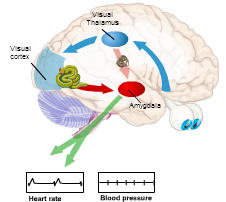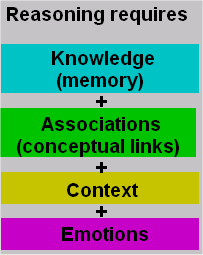09 Aug Emotional Intelligence
What Does it Take to Think
In describing the role of the hippocampus, we discussed the correlation of various sensory inputs to form a cohesive picture of our physical surroundings. The direct links between the amygdala and the central gray matter demonstrate the importance of emotional feedback or emotional intelligence in cognitive processes. Dr. Travis Bradberry explains that “As you train your brain by repeatedly practicing new emotionally intelligent behaviors, your brain builds the pathways needed to make them into habits. Before long, you begin responding to your surroundings with emotional intelligence without even having to think about it. And just as your brain reinforces the use of new behaviors, the connections supporting old, destructive behaviors will die off as you learn to limit your use of them. ” (Bradberry 2015). The habituation is more a matter of emotional control than intellectual re-reasoning. The illustration below shows just how interconnected the emotional center is with multiple specialized brain centers. To get more information on the links between emotions and reasoning (see LeDoux, 1996).
| Understanding Context Cross-Reference |
|---|
| Click on these Links to other posts and glossary/bibliography references |
|
|
|
| Prior Post | Next Post |
| Layers of Brain Complexity | Emotions – The Perturbable Amygdala |
| Definitions | References |
| sensory inputs | Pansky 1988 |
| amygdala emotion | LeDoux 1996 |
| Cognitive Modeling | UTH |
 The full range of emotions are processed in the Amygdala, often forming feedback loops with other components of the brain. There is a very instructive animation on the University of Texas Health website showing a couple different pathways (Figures 6.9 and 6.10).
The full range of emotions are processed in the Amygdala, often forming feedback loops with other components of the brain. There is a very instructive animation on the University of Texas Health website showing a couple different pathways (Figures 6.9 and 6.10).
As I post to the sections on Logic and Cognitive Modeling, and elsewhere in this blog, I will examine the role of emotions in cognitive processing. Machines, such as computers, have seldom demonstrated a capacity for emotion. They have occasionally, however, been ascribed characteristics like finicky and stubborn. Here is an important question to consider at this point in the discussion of the human central-processing unit (the brain):
 Do we require emotions for complex reasoning? The answer: YES! Can machines be endowed with the capacity to process emotions? Stay tuned for the answer to that one. I believe that reasoning requires knowledge (memory), associations (conceptual links), context and emotions. Take away any of these, and the breadth of brain tasks the wanna-be sentient machine will be able to mimic goes down dramatically. To become sentient, mechanical brains will need the ability to possess emotional intelligence, and use it to reason and act. Is sentience a reasonable goal? I don’t know, but I foresee a world in which such machines make our lives better in some way.
Do we require emotions for complex reasoning? The answer: YES! Can machines be endowed with the capacity to process emotions? Stay tuned for the answer to that one. I believe that reasoning requires knowledge (memory), associations (conceptual links), context and emotions. Take away any of these, and the breadth of brain tasks the wanna-be sentient machine will be able to mimic goes down dramatically. To become sentient, mechanical brains will need the ability to possess emotional intelligence, and use it to reason and act. Is sentience a reasonable goal? I don’t know, but I foresee a world in which such machines make our lives better in some way.
Summary
We have covered a fair amount of ground so far in my posts in this section on the brain. Much of the information may be only marginally useful when it comes time to construct a computer model to act as a mechanical brain. Please remember these three facts:
1) neurons have structural differences that correspond to their functions;
2) different areas of the brain perform radically different functions; and
3) emotional feedback is part of all cognitive activities.
As background, especially for the information covered in the posts on neurons and the biological neural network, it will undoubtedly prove most valuable in helping you relate to some of the concepts presented in those posts.
 Posts in this section of the blog have many homespun and many purchased graphics. The sections on Neurons and Biological Neural Networks also have some intense brain artwork to help support the learning process. Hopefully, these graphics will be useful to you and help in your study. As I have borrowed liberally from many others in drawing these, I owe a debt of gratitude to the artists on whose work they were based.
Posts in this section of the blog have many homespun and many purchased graphics. The sections on Neurons and Biological Neural Networks also have some intense brain artwork to help support the learning process. Hopefully, these graphics will be useful to you and help in your study. As I have borrowed liberally from many others in drawing these, I owe a debt of gratitude to the artists on whose work they were based.
Further Reading
In the topic index of the bibliography you will find applicable references under the Neuroscience topic. These are my personal favorites of the references in this subject area:
The Enchanted Loom – Corsi, 1991;
From Neuron to Brain – Kuffler, 1984;
The Biology of the Brain – Llinás, 1989;
Emotional Intelligence 2.0 – Bradberry 2009;
Review of Neuroscience – Pansky, 1988.
| Click below to look in each Understanding Context section |
|---|









